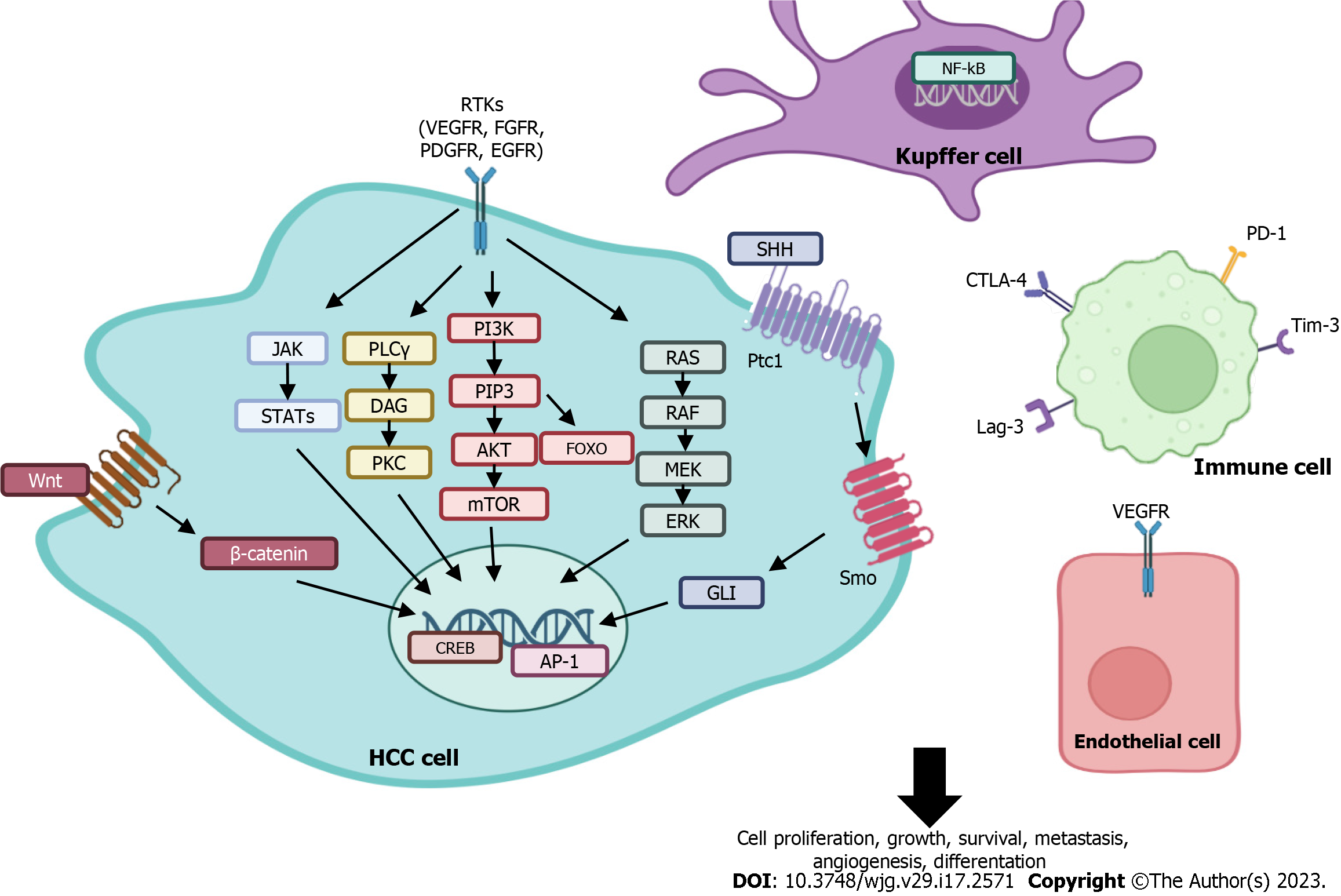Copyright
©The Author(s) 2023.
World J Gastroenterol. May 7, 2023; 29(17): 2571-2599
Published online May 7, 2023. doi: 10.3748/wjg.v29.i17.2571
Published online May 7, 2023. doi: 10.3748/wjg.v29.i17.2571
Figure 1 Critical signalling pathways involved in hepatocellular carcinoma progression.
Systemic therapy primarily targets signalling pathways triggered by tyrosine kinase receptors expressed on tumour cells, which are known to play an essential role in liver carcinogenesis. However, Wnt/B-catenin and Smo (hedgehog pathway) signalling are also important components in liver cancer development. Furthermore, Kupffer cells, immune cells, and endothelial cells are part of the tumour microenvironment, and activation of critical signalling pathways in these cells may also contribute to cancer development. Indeed, the expression of immune checkpoint molecules (cytotoxic T-lymphocyte-associated protein 4, programmed cell death protein 1, Lag-3, Tim-3) on the surface of immune cells play an essential role in the development of hepatocellular carcinoma (discussed in the main text). RTK: Receptor tyrosine kinase; VEGFR: Vascular endothelial growth factor receptor; FGFR: Fibroblast growth factor receptor; PDGFR: Platelet-derived growth factor receptors; EGFR: Endothelial growth factor receptor; JAK: Janus kinase; STAT: Signal transducer and activator of transcription; PLCγ: Phospholipase C-γ; DAG: Diacylglycerol; PKC: Protein kinase C; PI3K: Phosphoinositide 3-kinase; PIP3: phosphatidylinositol 3,4,5-trisphosphate; mTOR: Mechanistic target of rapamycin; FOXO: Forkhead box O; AP-1: Activating protein-1; CREB: Cyclic AMP response element binding; NF-kB: Nuclear factor kB; CTLA-4: Cytotoxic T-lymphocyte-associated protein 4; PD-1: Programmed cell death protein 1.
Figure 2 Pharmacological strategies for the treatment of advanced hepatocellular carcinoma.
When a patient is diagnosed with hepatocellular carcinoma either intermediate (BCLC B) or advanced (BCLC C) stage, surgical and locoregional therapeutic options are no longer indicated. In these cases, the most appropriate treatment option is systemic therapy with first-line treatments with sorafenib and lenvatinib as the initial drugs. However, if the patient develops resistance to sorafenib or disease progression after therapy, treatment with second-line drugs indicated in the schedule is initiated. It is important to note that immunotherapy using monoclonal antibodies is already part of the current and approved drug options. Because current drug treatments are limited and monotherapy is ineffective, the implementation of combination and drug repositioning are two therapeutic strategies to achieve more and better treatments. 1All agents require prior sorafenib use. BCLC: Barcelona Clinic Liver Cancer; TACE: Transarterial chemoembolization; CTLA-4: Cytotoxic T-lymphocyte-associated protein 4; PD-1: Programmed cell death protein 1; VEGFR: Vascular endothelial growth factor receptor; FGFR: Fibroblast growth factor receptor; PDGFR: Platelet-derived growth factor receptors; HCC: Hepatocellular carcinoma.
- Citation: Villarruel-Melquiades F, Mendoza-Garrido ME, García-Cuellar CM, Sánchez-Pérez Y, Pérez-Carreón JI, Camacho J. Current and novel approaches in the pharmacological treatment of hepatocellular carcinoma. World J Gastroenterol 2023; 29(17): 2571-2599
- URL: https://www.wjgnet.com/1007-9327/full/v29/i17/2571.htm
- DOI: https://dx.doi.org/10.3748/wjg.v29.i17.2571










